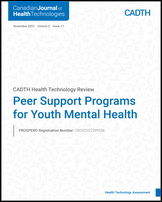|
Anxiety
Post-booster: 97 (1 RCT
39
)
Longest follow-up: 55 (1 RCT
40
)
| One RCT39,40 with high risk of bias (unclear direction) reported on participants’ self-reported anxiety symptoms. The trial39 compared HOP-C with no peer support among university students with self-identified mental health concerns. The participants (n =117) were mostly female (82.2%), White (68.6%) and heterosexual (66.9%), and reported depressive symptoms (85.5%). Anxiety symptoms were assessed using Generalized Anxiety Disorder 7-Item scale62,63 (score range 0 to 21), with higher scores indicating increased severity of symptoms.63 At post-booster and at the 2-month follow-up, there were no difference in self-reported improvement in anxiety symptoms between HOP-C and waitlist groups (p values 0.213 and 0.252 respectively). |
Very low
due to serious concerns for risk of bias, concerns for inconsistency, serious concerns for indirectness and imprecision.a
| There may be little to no difference in the effect of HOP-C vs. TAU on self-reported anxiety symptoms post-booster, but the evidence is very uncertain. There may be little to no difference in the effect of HOP-C vs. waitlist control on self-reported anxiety symptoms at follow-up, but the evidence is very uncertain. |
